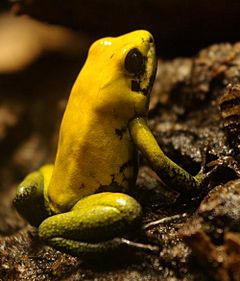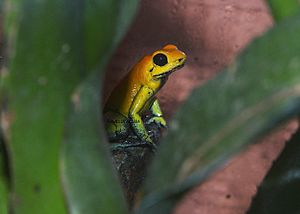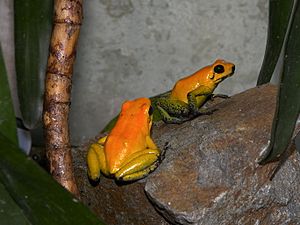Black-legged Dart Frog facts for kids
Quick facts for kids Phyllobates bicolor |
|
|---|---|
 |
|
| Scientific classification | |
| Kingdom: | |
| Phylum: | |
| Class: | |
| Order: | |
| Suborder: | |
| Family: | |
| Genus: | |
| Species: |
P. bicolor
|
| Binomial name | |
| Phyllobates bicolor (Duméril and Bibron, 1841)
|
|
The Black-legged Dart Frog (Phyllobates bicolor), also known as the bicolored dart frog, is a very special type of poison dart frog. It's known for being one of the most toxic frogs found in the wild. People in the Choco region sometimes call it the Neari.
About the Black-legged Dart Frog
The Black-legged Dart Frog is one of the biggest poison dart frogs. Male frogs usually grow to be about 4.5 to 5 centimeters long, from their nose to their rear end. Females are a little bigger, reaching about 5 to 5.5 centimeters.
These frogs can be many different colors, from a warm orange to a bright yellow. They often have a blue or black tint on their legs, which is how they got their name. They are a bit smaller and thinner than their close relative, the Golden Poison Frog (Phyllobates terribilis). Sometimes, young Golden Poison Frogs can look similar to them.
Amazing Poison Power
Even though its poison isn't quite as strong as the Golden Poison Frog's, the Black-legged Dart Frog is still extremely toxic. It's one of the few frogs that has a poison powerful enough to harm humans. Just a tiny amount of its poison, about 150 micrograms, is incredibly potent.
Local people sometimes carefully heat these frogs over a flame. This makes the frog "sweat" its liquid poison, which is then collected for hunting darts. The poison works by making muscles and breathing stop. Scientists are studying this poison, called batrachotoxin, to see if it could be used to make medicines.
It's important to know that dart frogs raised in captivity are not poisonous. This is because they get their poison from special chemicals found in the insects they eat in the wild. When they are kept as pets, their food doesn't have these chemicals, so they don't produce the poison.
Daily Life and Family
Like many frogs in its group, the Black-legged Dart Frog mostly lives on the ground. They only climb into trees when they are raising their young. Most of these frogs prefer to live alone, but sometimes you can find groups of them in the wild.
Unlike many other frog species, both male and female Black-legged Dart Frogs can make sounds. They produce high-pitched calls that sound a bit like birds. These frogs are active mostly during the day. At night, they hide away in the fallen leaves on the forest floor.
During the wet season, Black-legged Dart Frogs, like all dart frogs, gather in large groups to find mates. The male Black-legged Dart Frog is a very caring parent. He carries his tadpoles on his back! The tiny tadpoles stick to a special mucus on their father's back. He then carries them to small puddles of water. There, he feeds and protects them until they grow into tiny froglets. Once they become froglets, they are ready to live on their own and start their adult lives.
See also
 In Spanish: Phyllobates bicolor para niños
In Spanish: Phyllobates bicolor para niños



